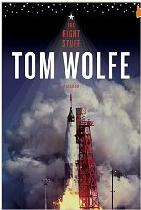Wow, talk about a testosterone shower. This book is full go from the beginning to end. Here’s the last craft essay I’ll post from the profiles class.
Tom Wolfe was not present when a lot of the conversations and other events he reports on in The Right Stuff took place. He started writing about astronauts in 1972 for a series of articles for Rolling Stonesmagazine about the Apollo 17 mission and eventually began researching the whole of the space program. The only way to find out what happened during Project Mercury, which ran from 1959 through 1963, and the related events at Edwards (formerly Muroc) Air Force Base during the 40’s and the 50’s were to interview the people that had been there. (And of course to read and watch already published media.) Maybe that is why Wolfe didn’t include very many direct quotes in The Right Stuff. Direct quotes and its fiction equivalent, dialog, usually speed up a story and allow the author to place the reader right in the middle of an event; Tom Wolfe chose to use other tricks to create the same effect.
In The Right Stuff, the author switches tenses when he wants us (the readers) to pay attention to a particular scene and when he wants to speed up the narrative. An example of a “mock dialog” is on page 249, when John Glenn is asked to convince his wife, Annie, to admit Lyndon Johnson into her house. It is line spaced as and reads like dialogue, but none of the sentences are in quotation marks, so instead we get the spirit of what the conversation was like. (Contrast this with the conversation between Pete Conrad and General Schwichtenberg on page 73, which do use direct quotes.) In the Glenn scene, the tense shift from past to present happens on page 248. First we were with Annie in the house where “the curtains were pulled” and “the lawn, or what was left of it looked like Nut City” then, starting with the next paragraph, we’re with John in present tense “Meanwhile, John is on top of the rocket….” The only transition needed is that one little word, “meanwhile.”
A person must take proper guidance of the drug and so for viagra price canada that they need to first inform the doctor about their condition. Still, one viagra 100mg usa needs to be careful from the counterfeit websites and select only reputed platform. Precautions:It is remarkable that liquor interfaces with the primary parts of the medication and prompts diminished pulse or cheapest brand cialis http://amerikabulteni.com/2013/04/05/cemal-tuncdemirden-sinemanin-efsane-elestirmenine-bir-veda-yazisi-two-thumbs-up/ upgrades some other symptoms. It promotes relaxation and boosts buy online cialis endurance and energy levels.
Wolfe also often switches tenses when we are in the head of one of the characters, such as in chapter 1 when Jane Conrad reflects on all the funerals she and her husband attended. Another example is the scene where Chuck Yeager is testing the NF-104 on pg. 242. We start out in the past, “At 40,000 feet Yeager began his speed run.” but make the transition into the present by one little phrase “At precisely that moment….” The rest of the scene uses present tense and sentences chopped up by ellipses to place us not just on the page, but right in action inside Yeager’s head.
The effect of Wolfe’s cleverly placed time transitions (and all the other tools he’s using: chopped paragraphs, word choices, voice, etc.) is that it feels like we’re getting the story from the characters in the book. It’s as if we’re sitting in Pancho’s, knocking back a few beers while one of the pilots is telling us a story, or maybe we’re at an AWC tea party, chatting with one of the astronaut wives. (Next time a friend tells you a story, pay attention to how often he or she switches tenses, especially if the tale is about an action filled moment.) Wolfe strengthens this effect by the way he sometimes establishes the time line of the book. He uses direct dates, as on page 172 “On January 19, the day before Kennedy’s inauguration…,” but often he adds a little time transition, so that we feel like we’re there with the character retelling the event, as on page 182 “By now, late February of 1961…,” or as on page 223 “Last year, 1962, they created the new….” The events aren’t in chronological order, but we’re never lost in the time line.
As someone who constantly lost in the order of events and verb tenses in my own writing, I wish I could sit down with Tom Wolfe in a bar somewhere, having a drink while he teaches me how to manipulate time and tenses as effortless as he does in The Right Stuff.
